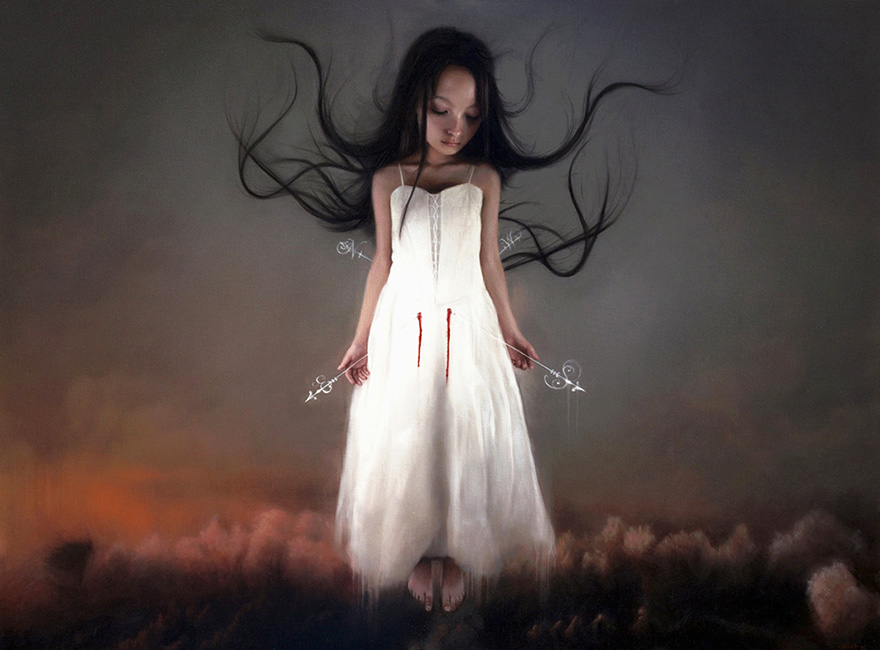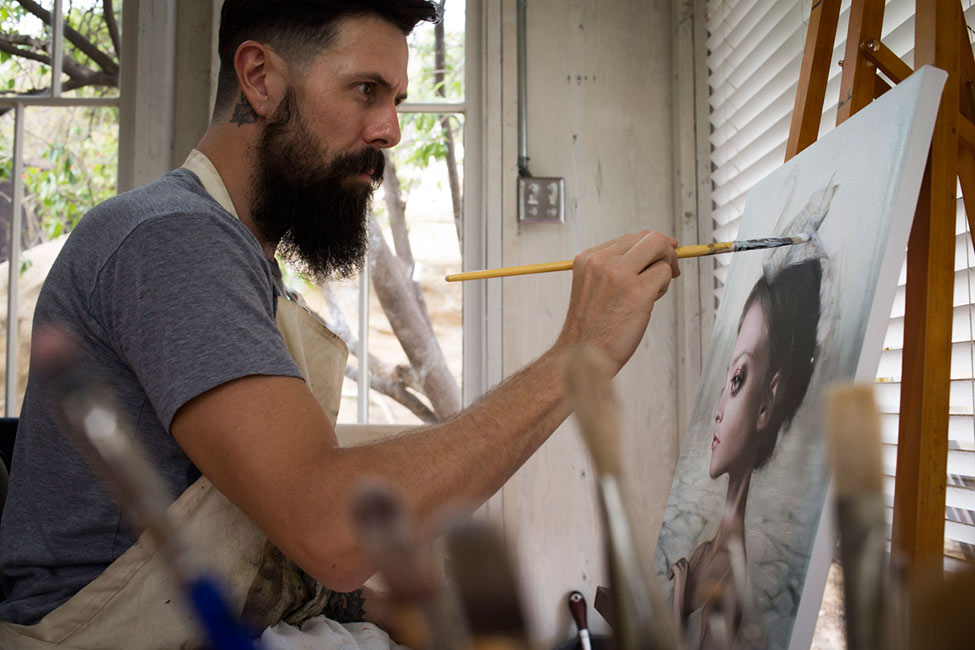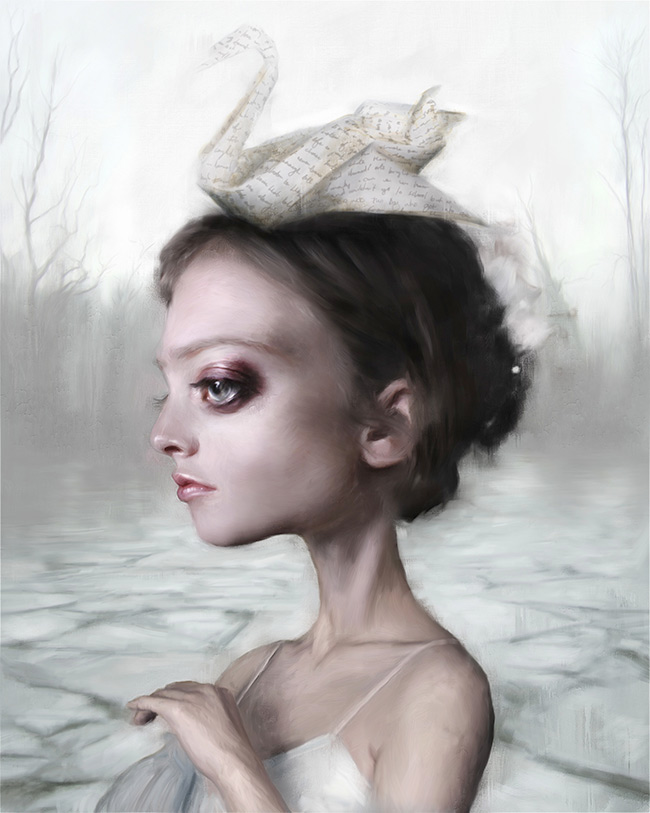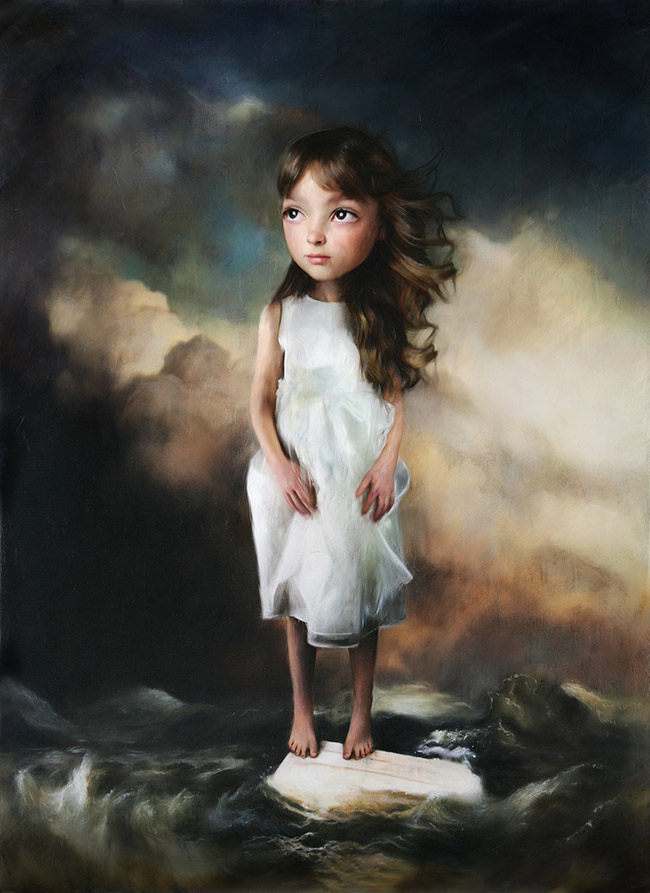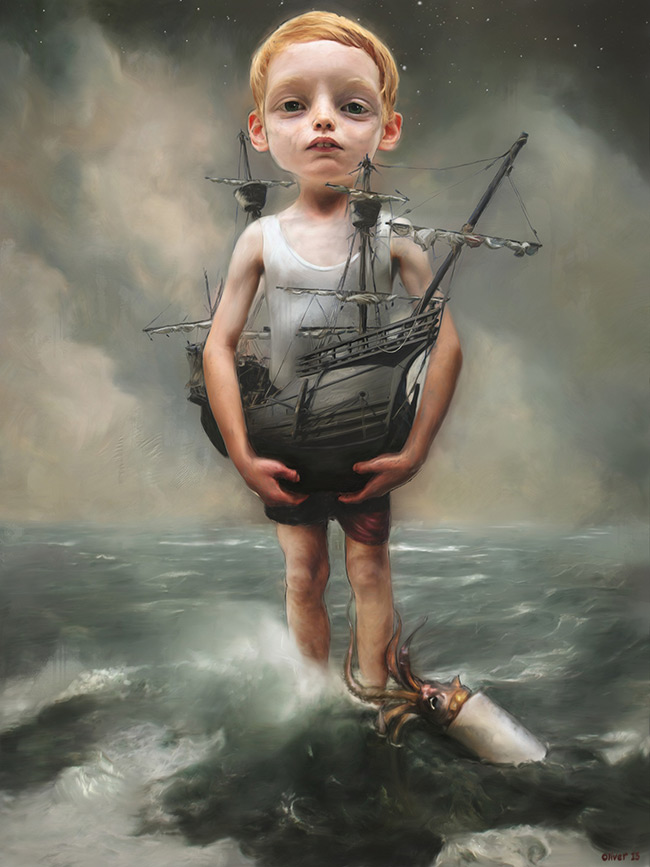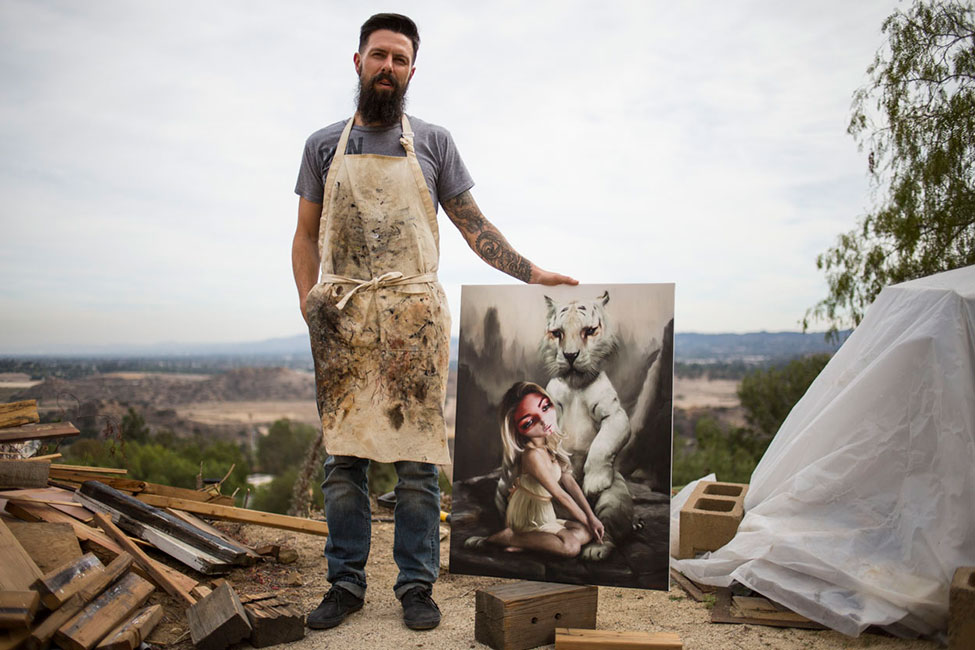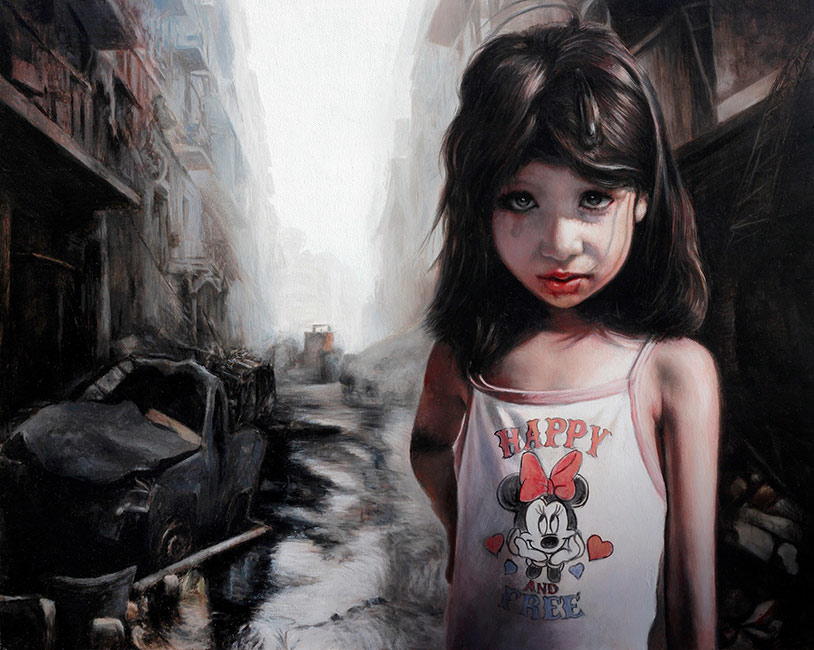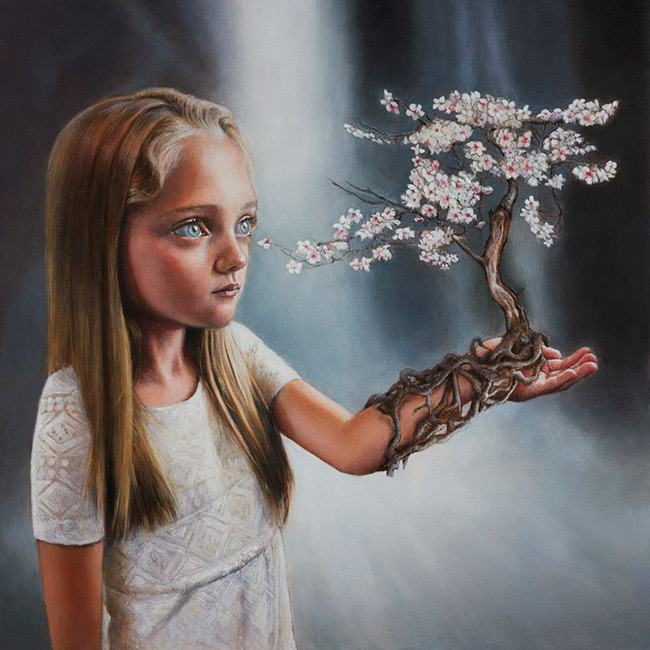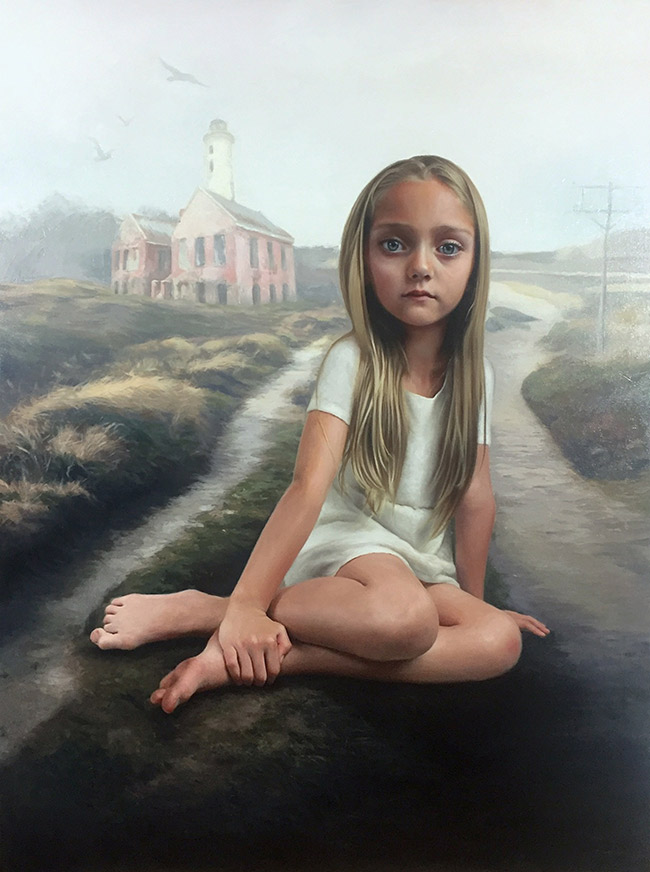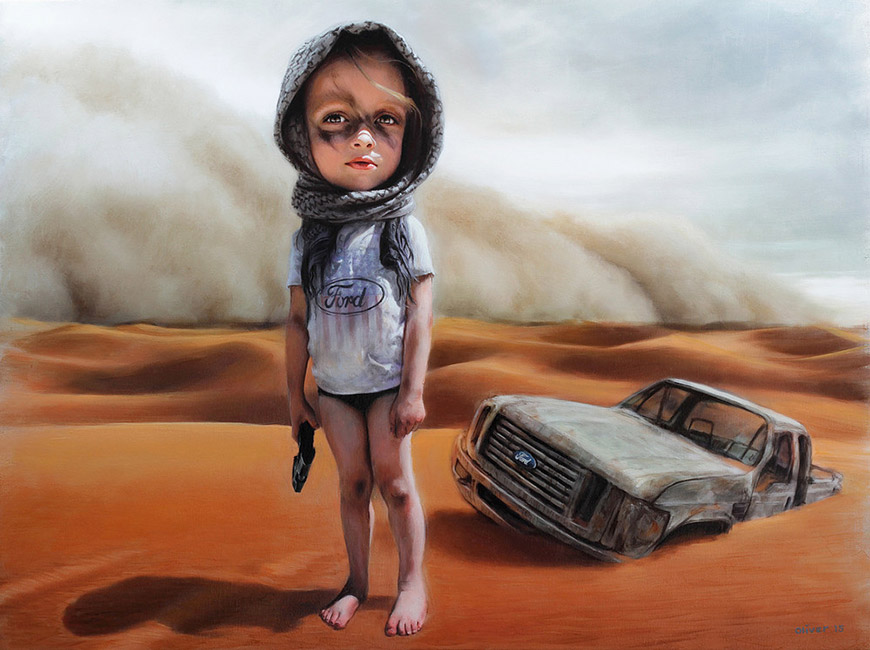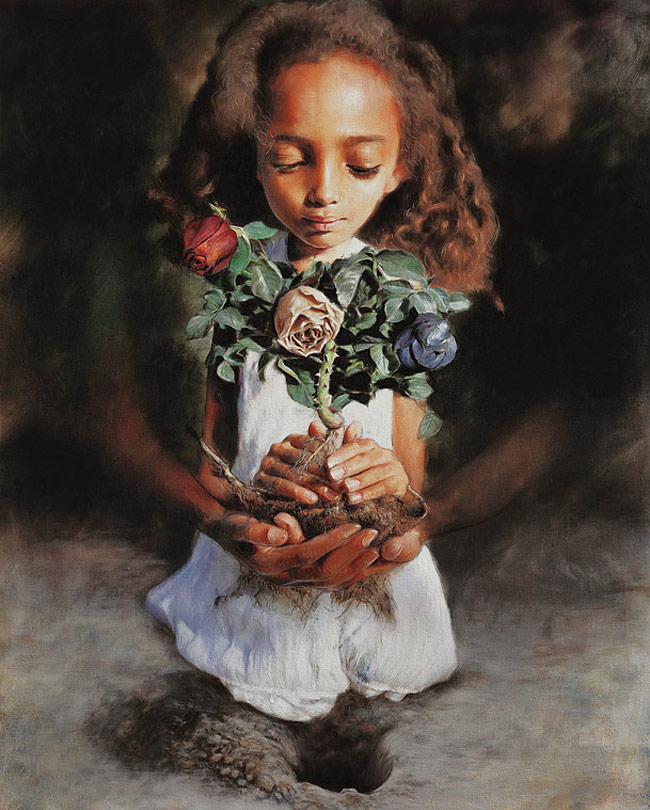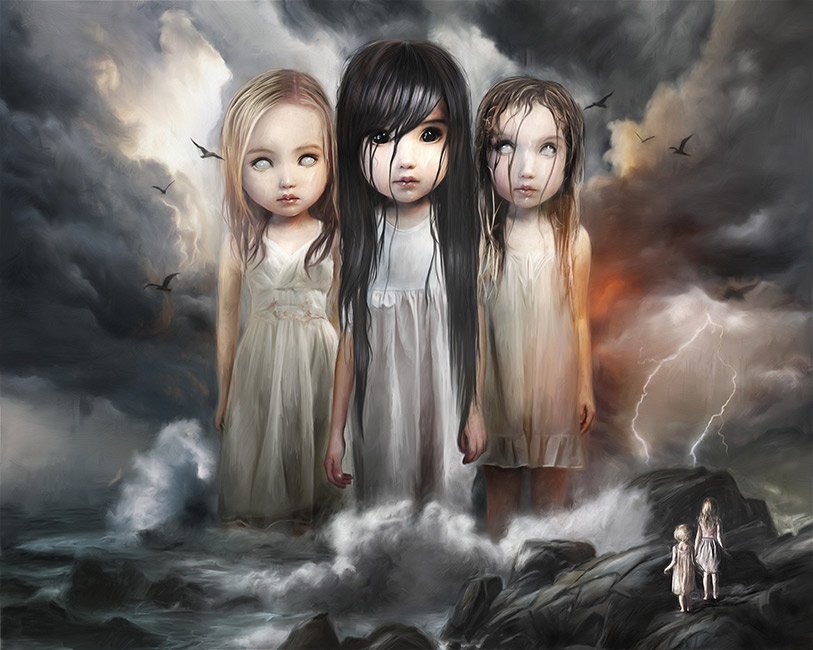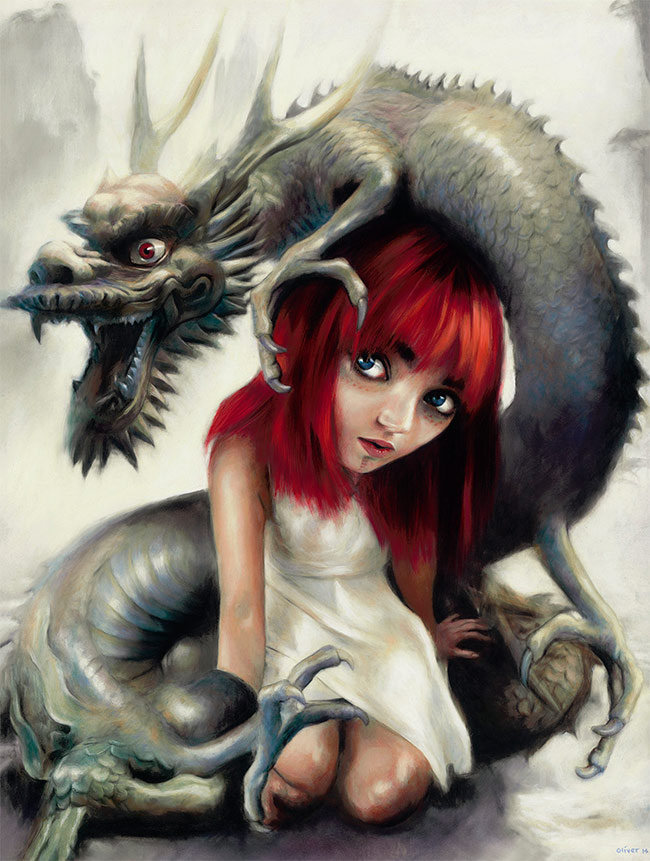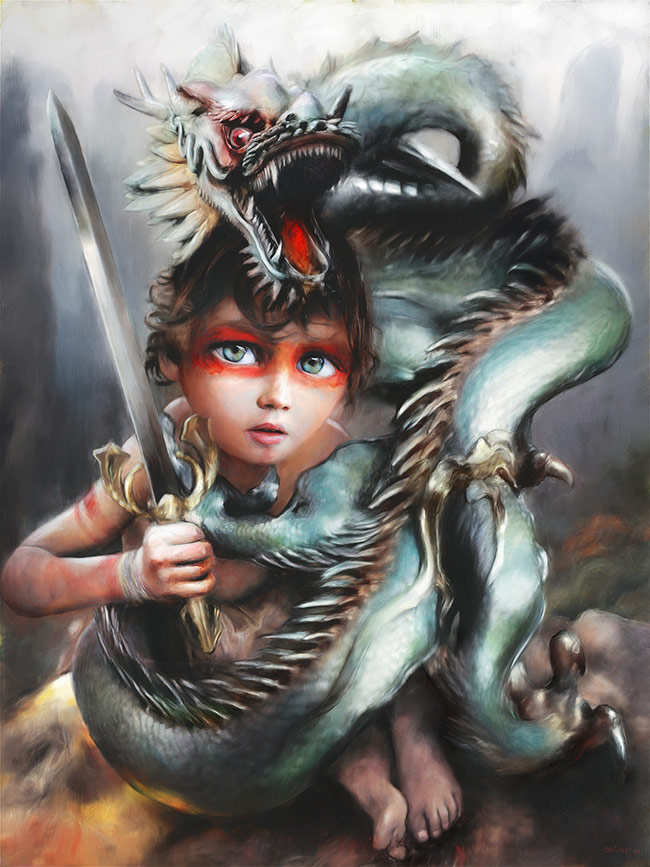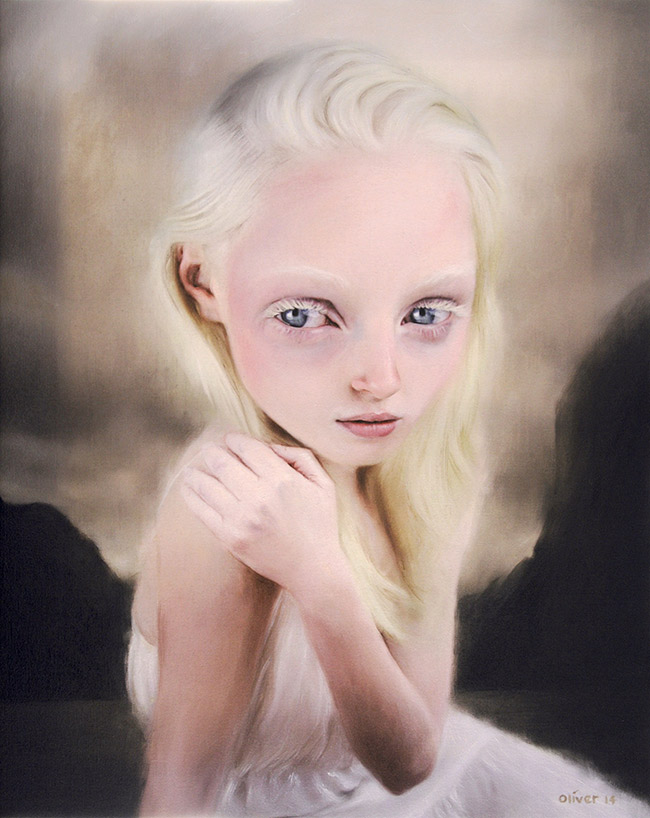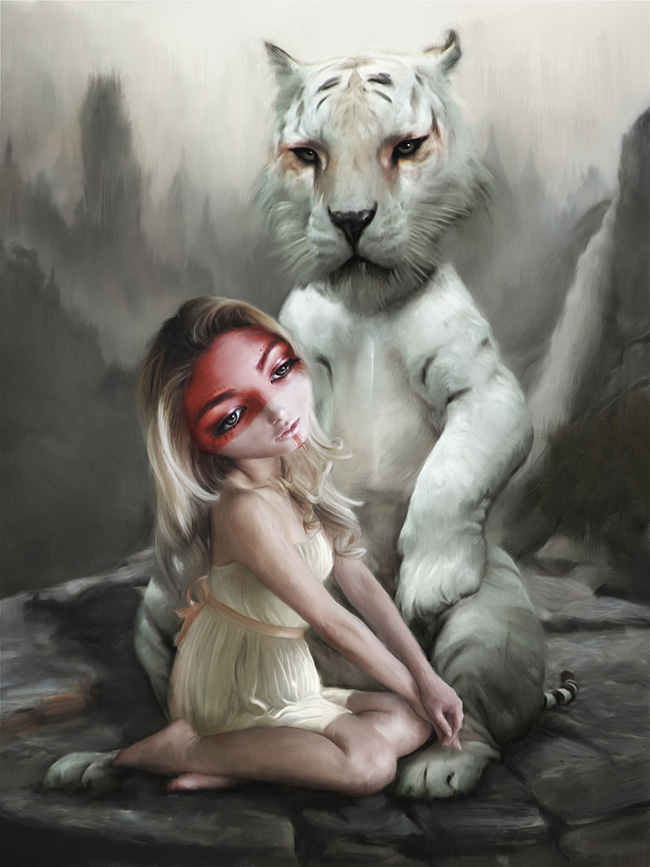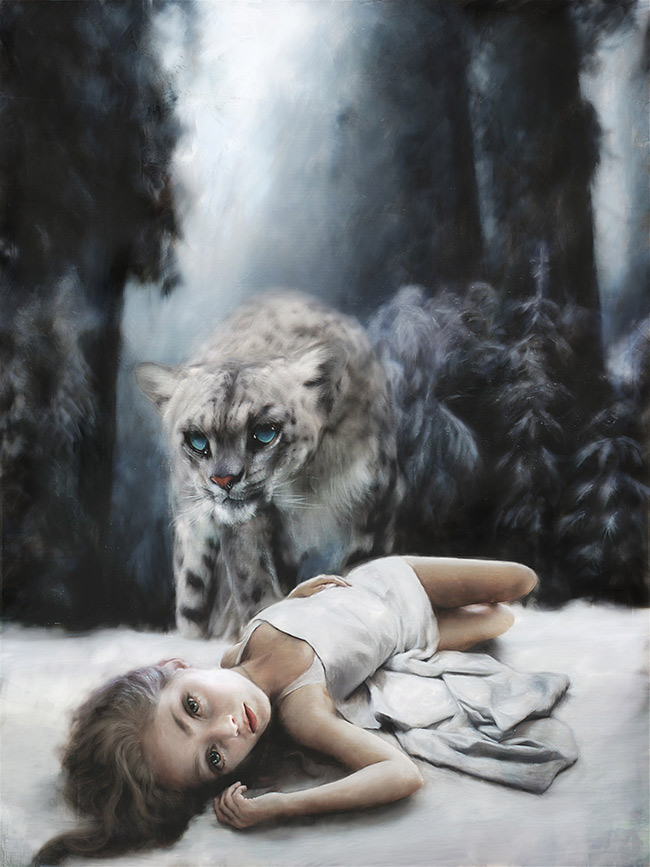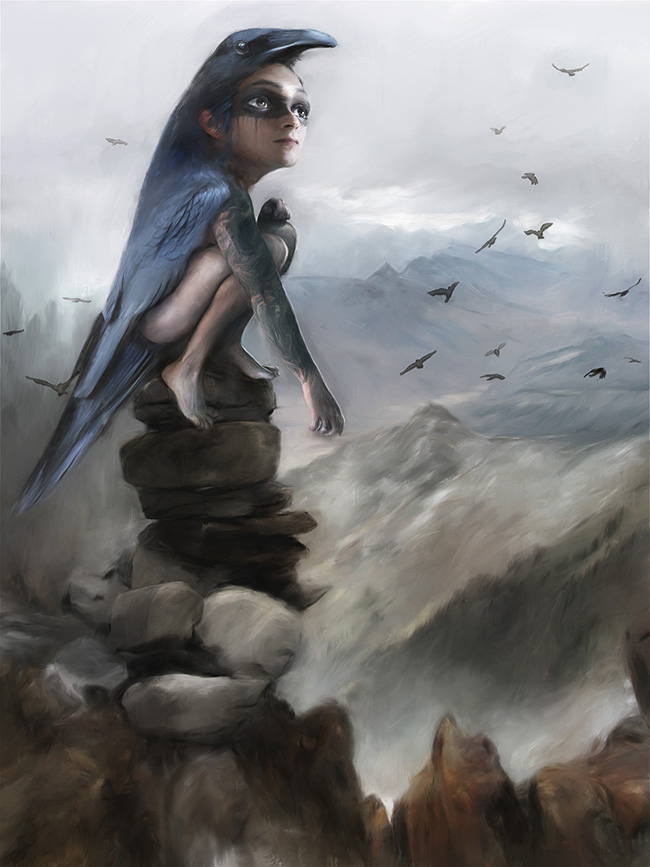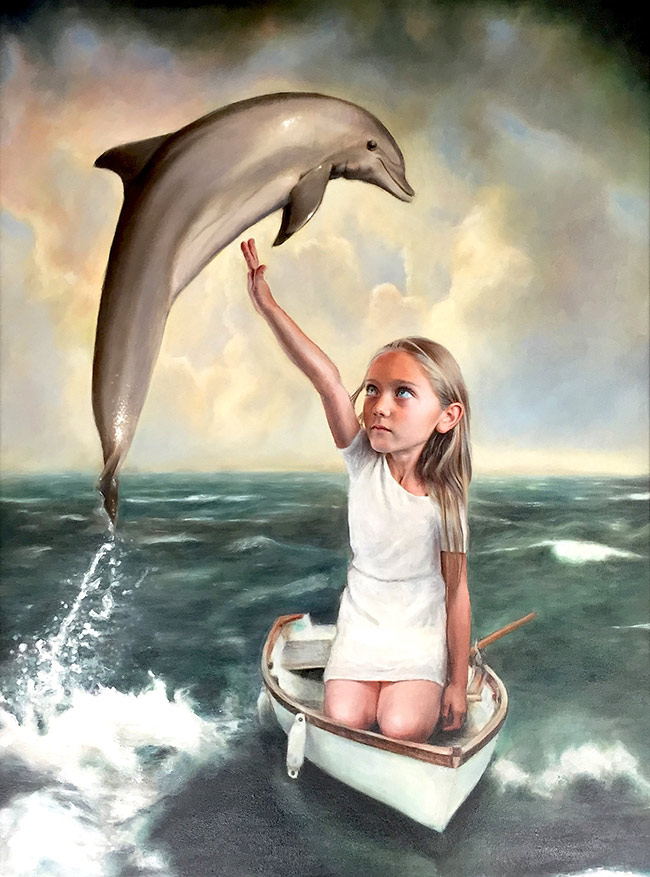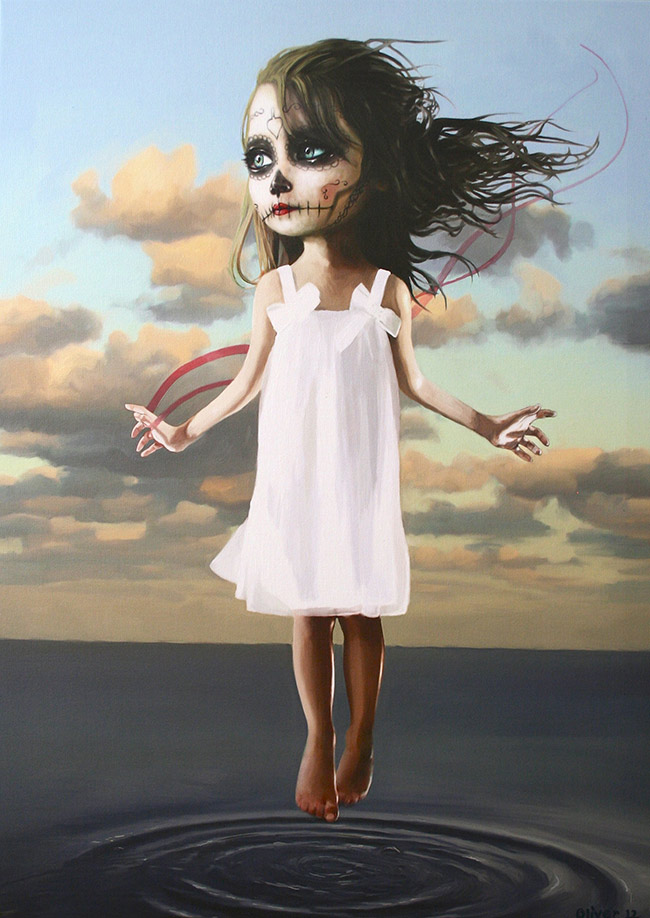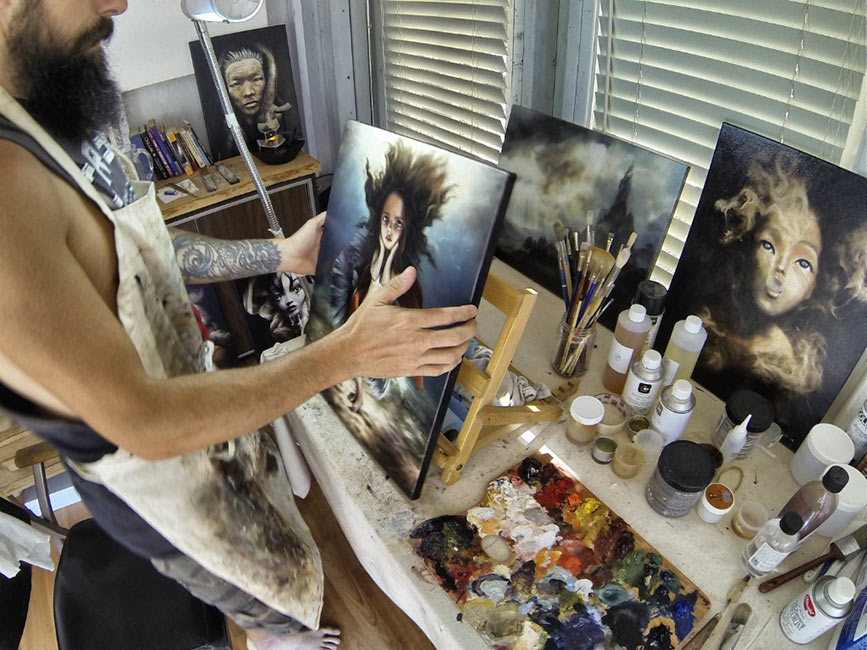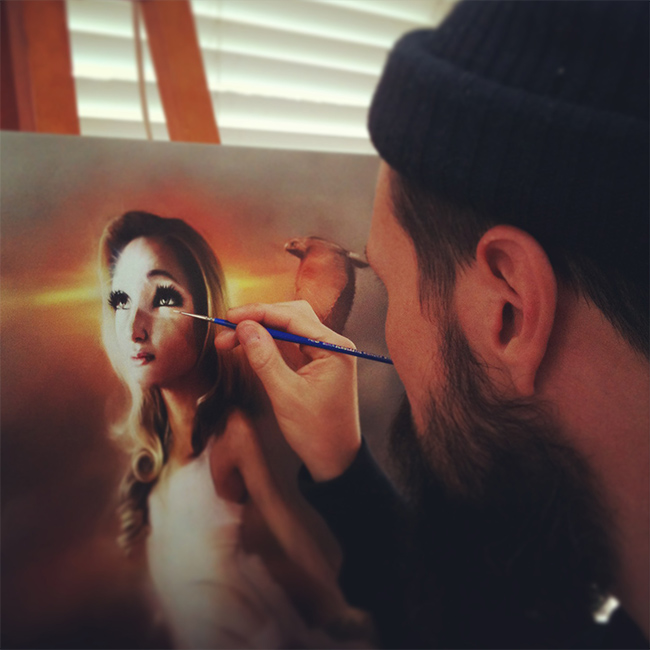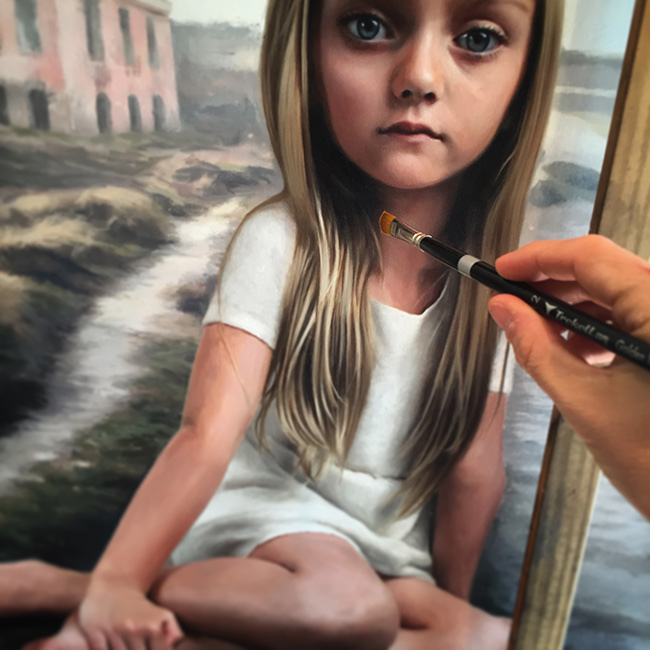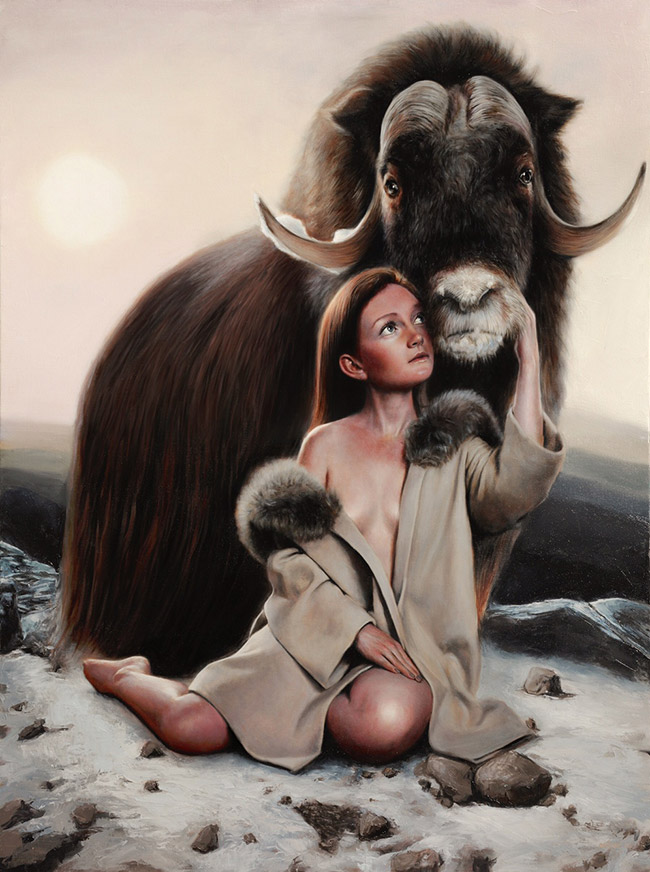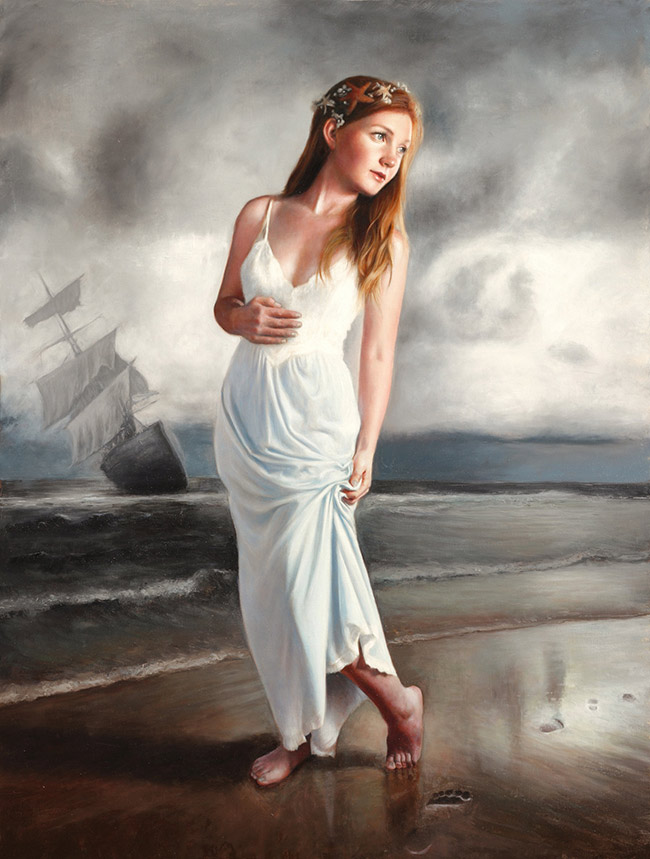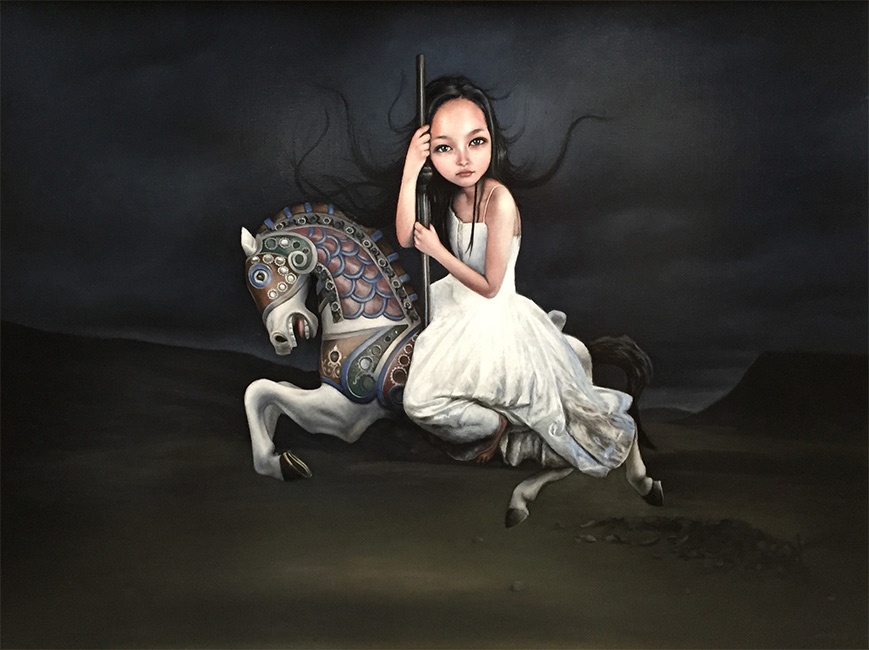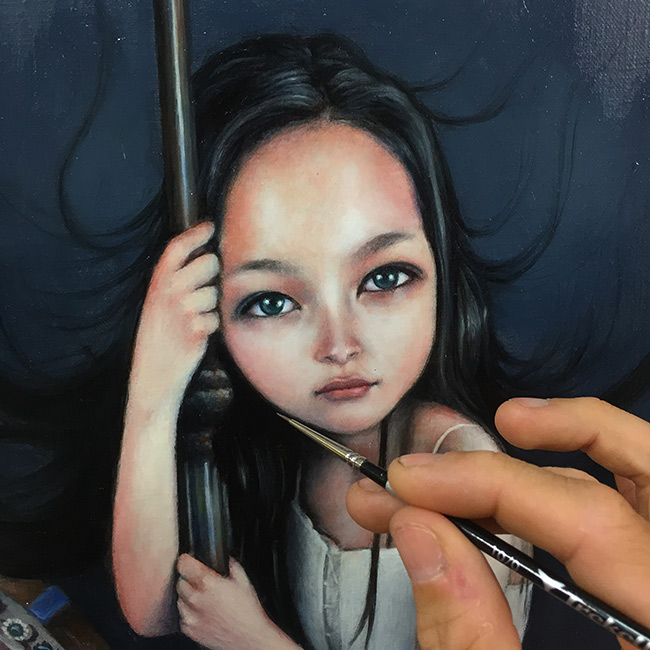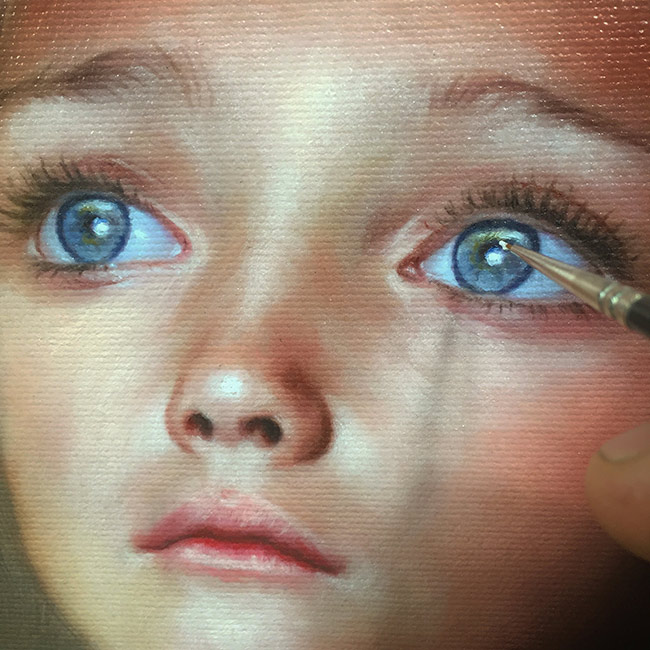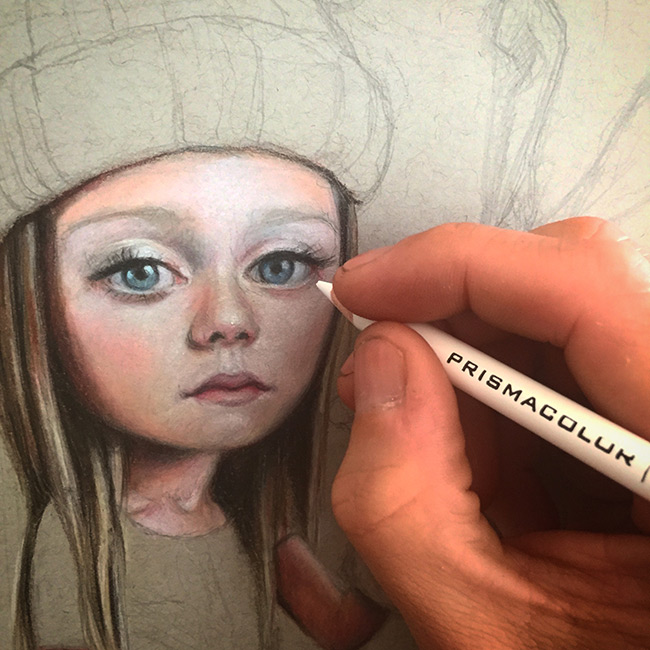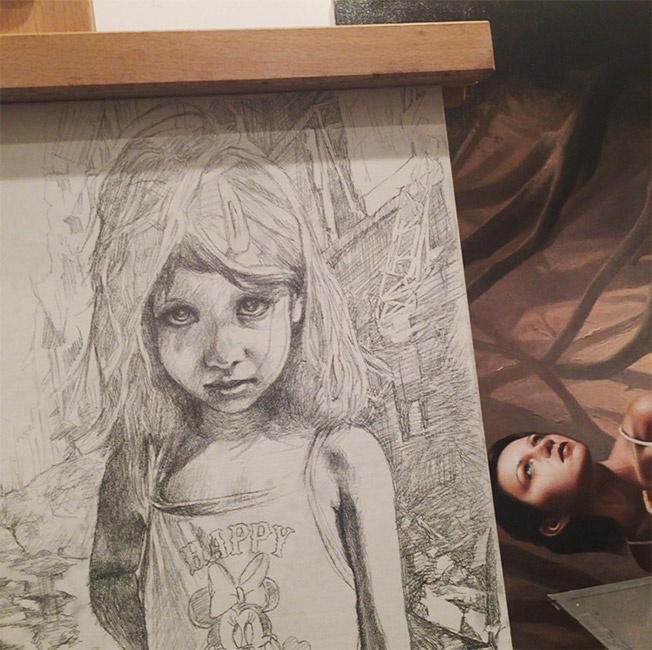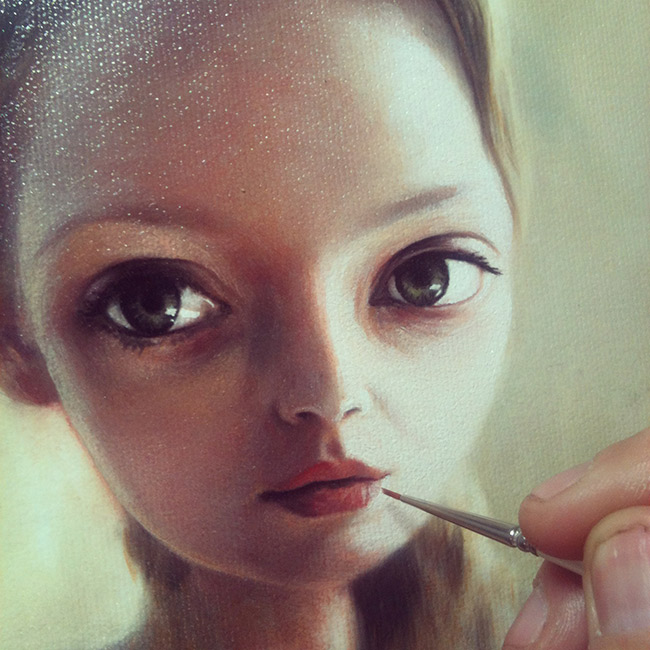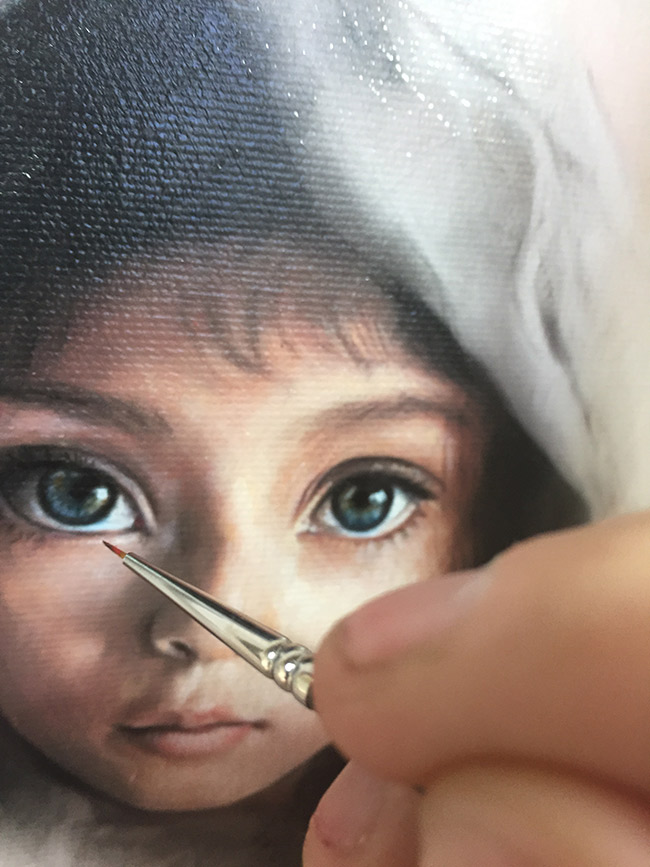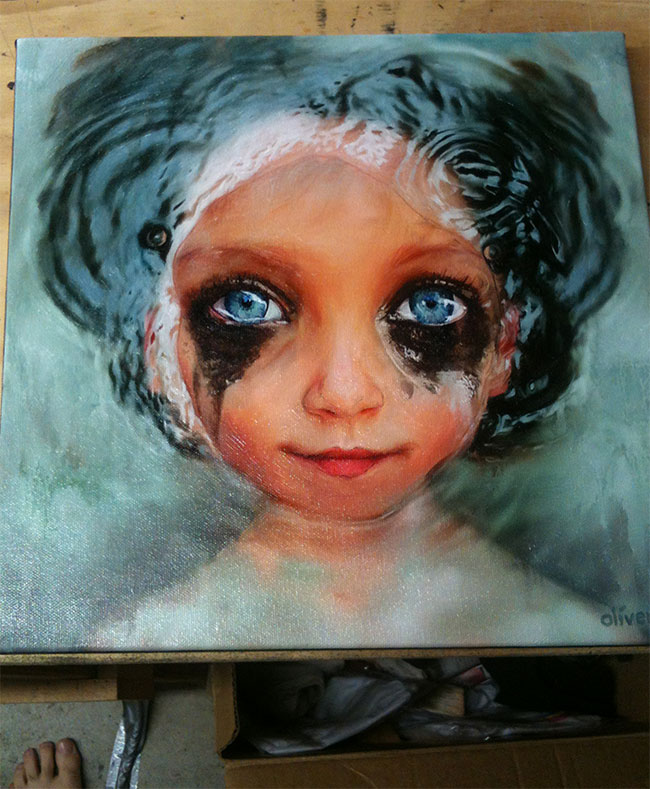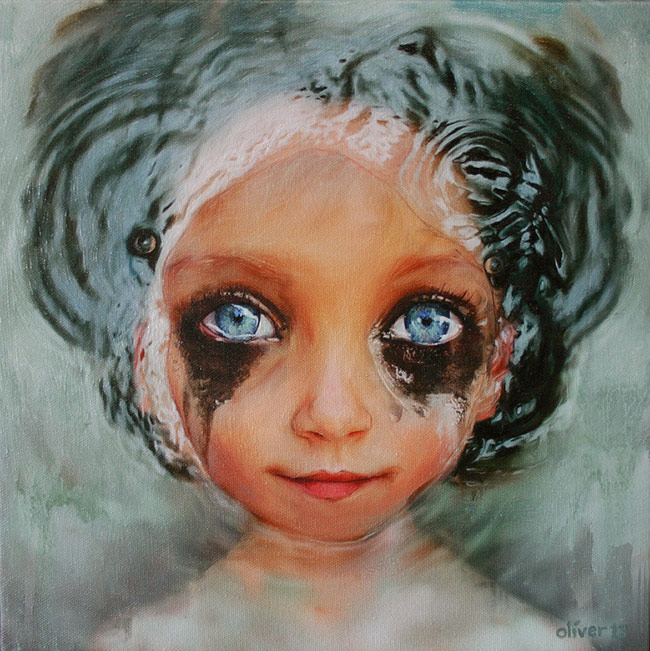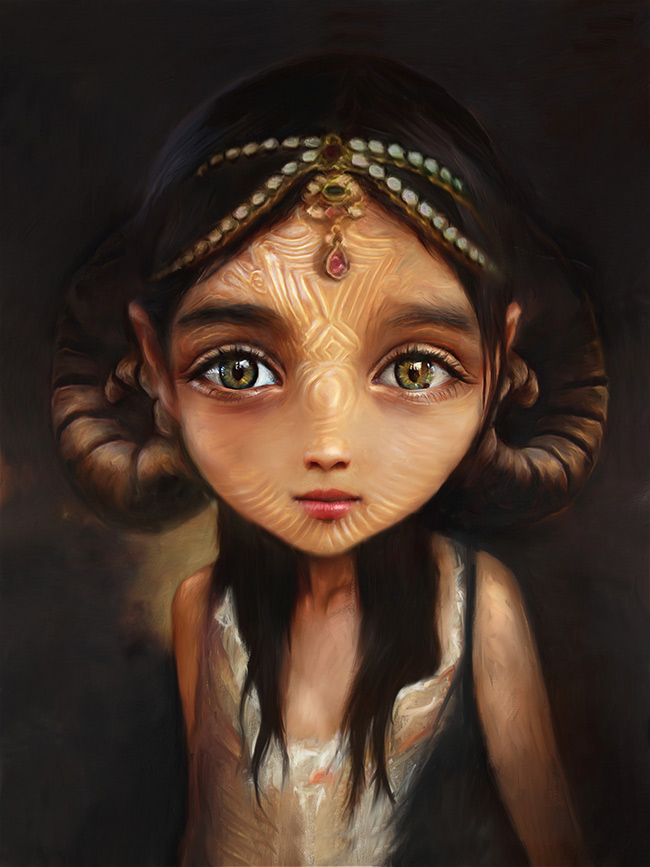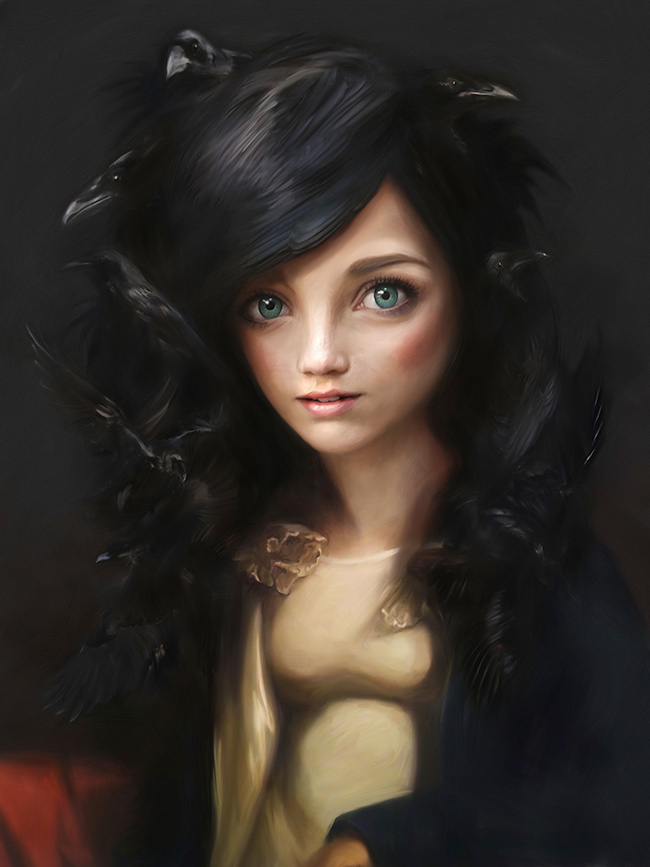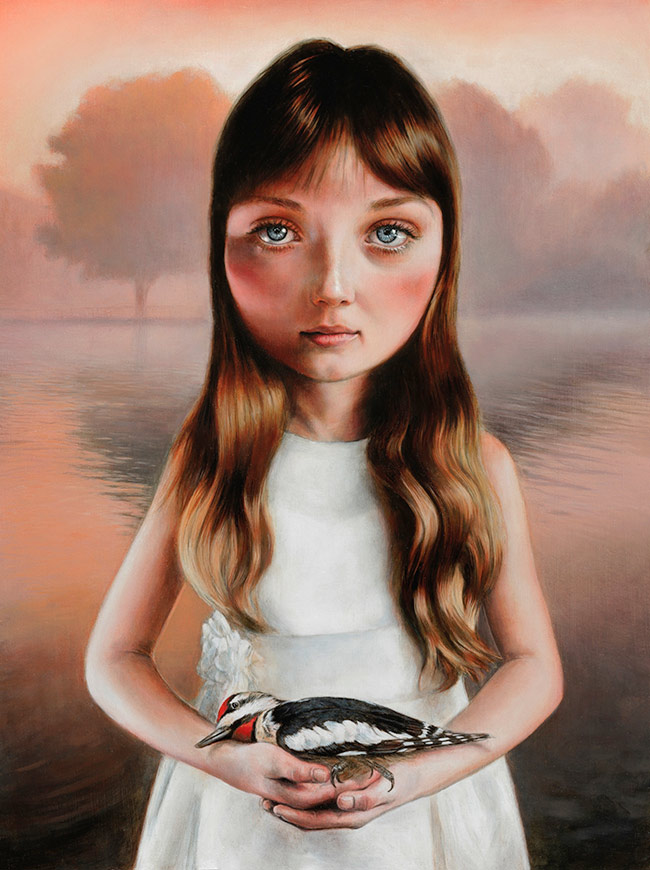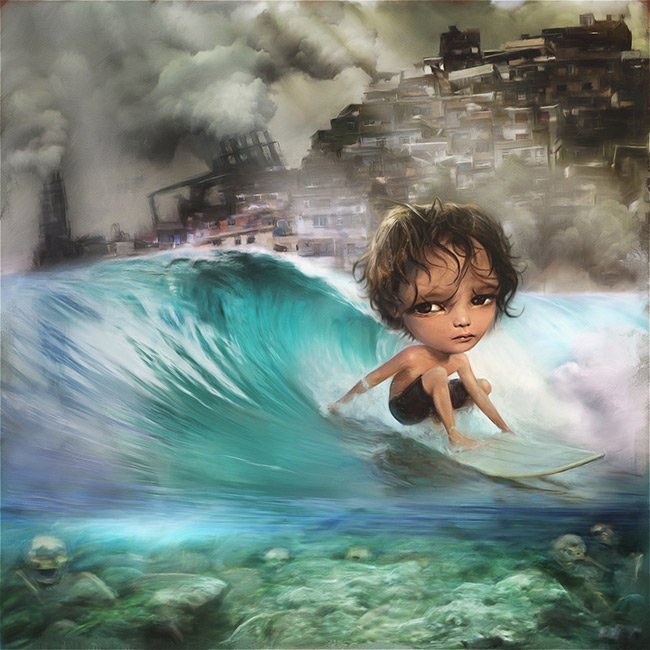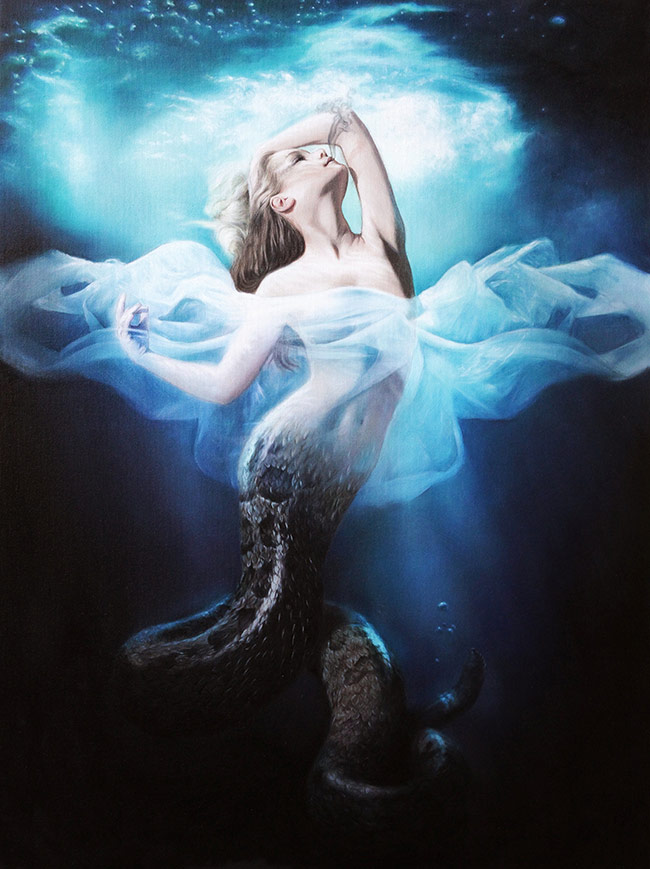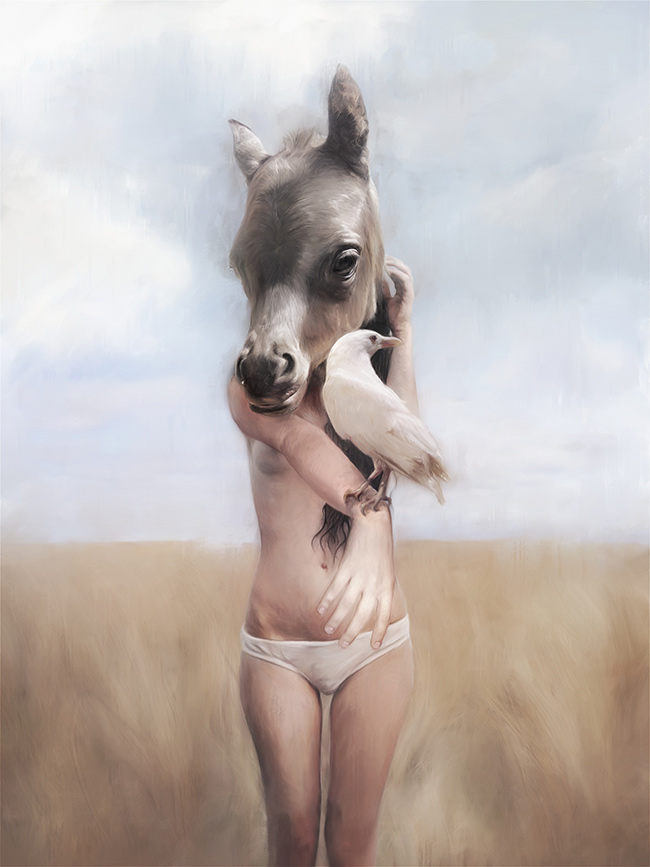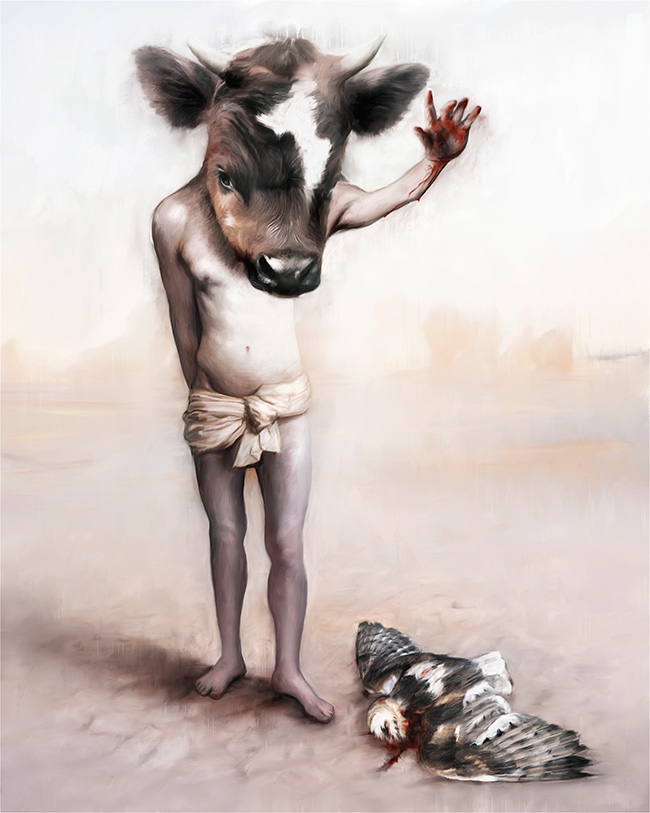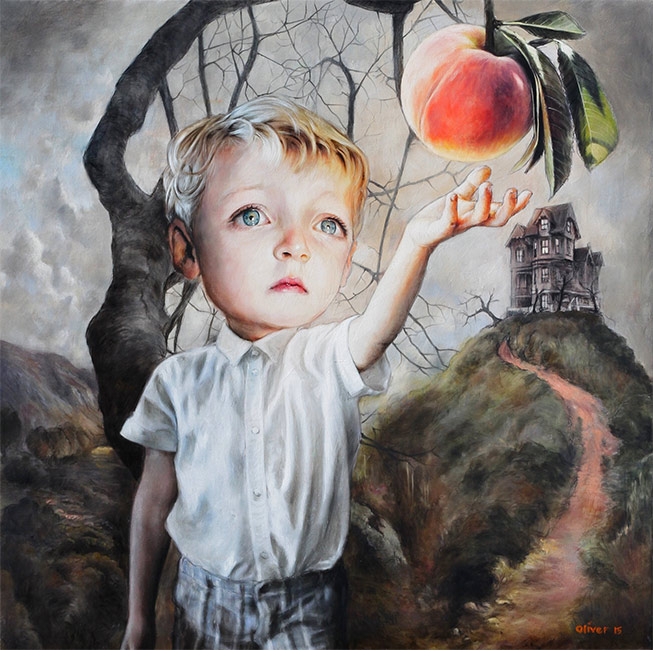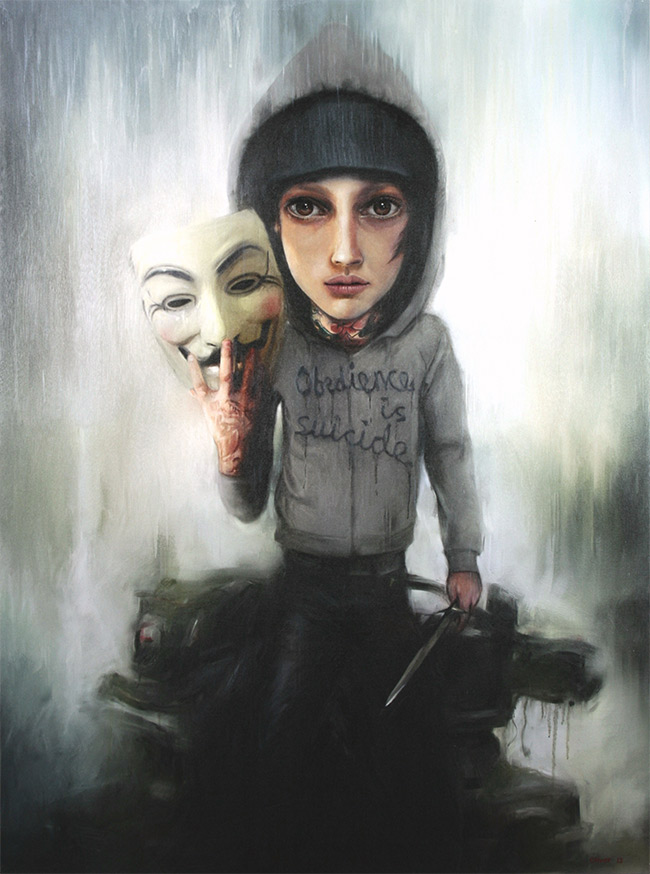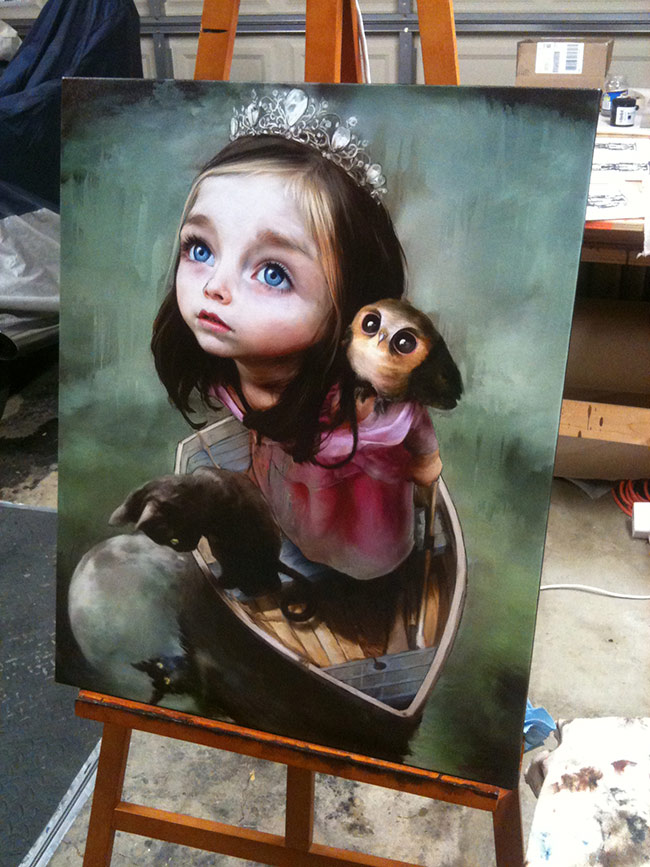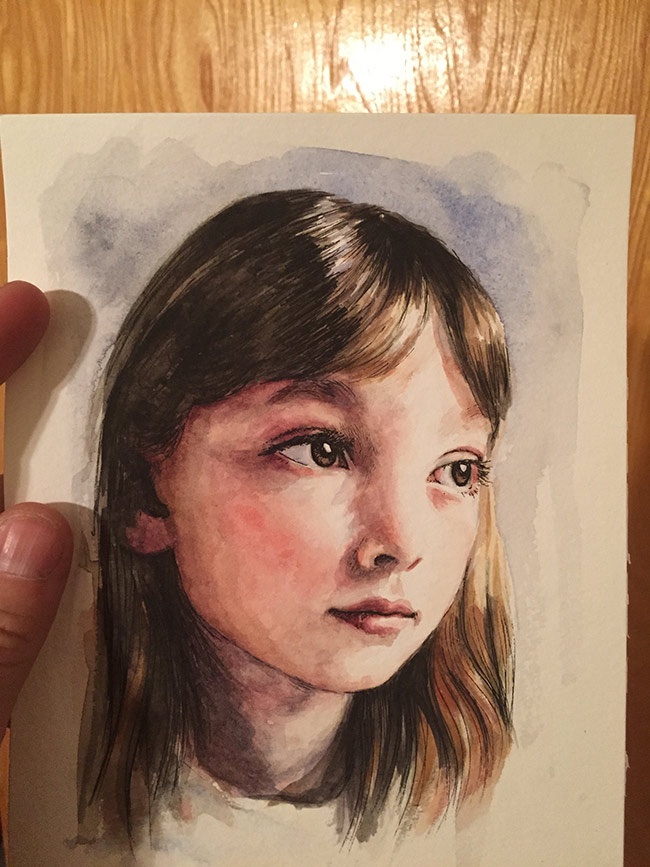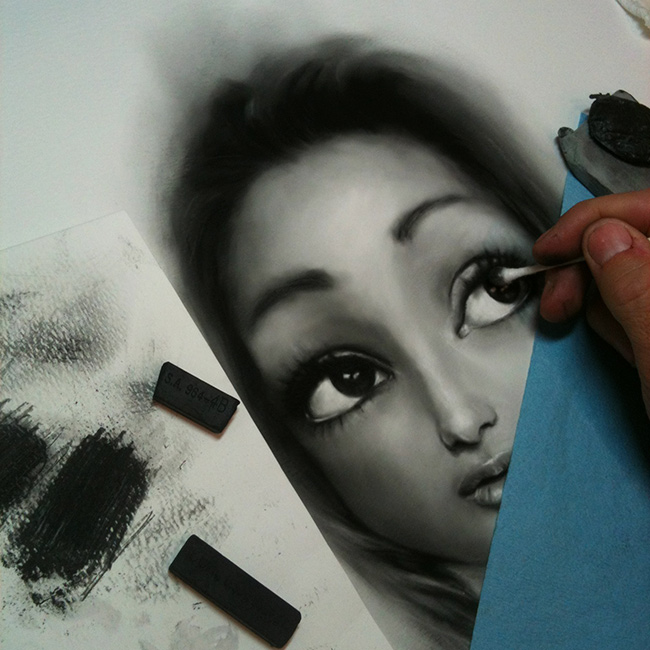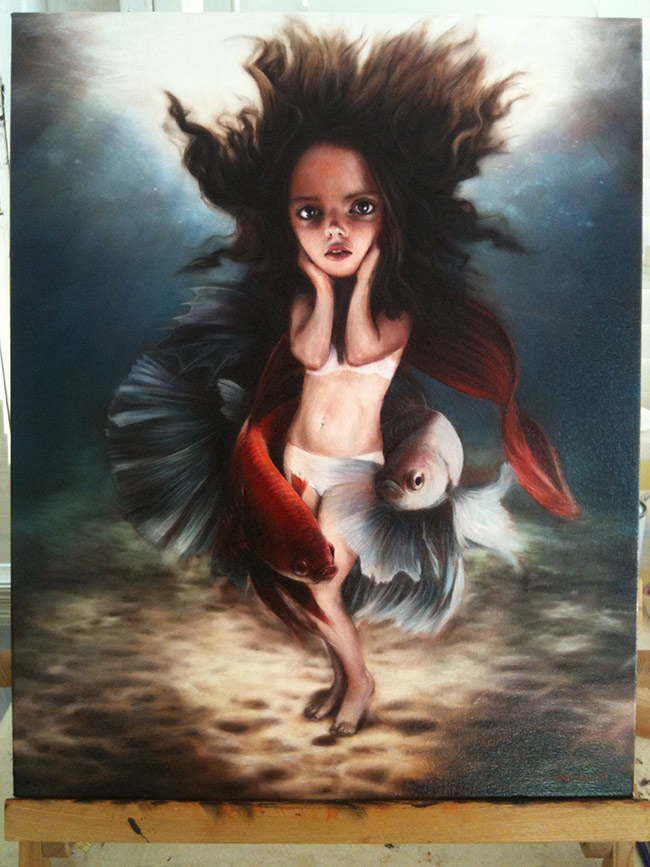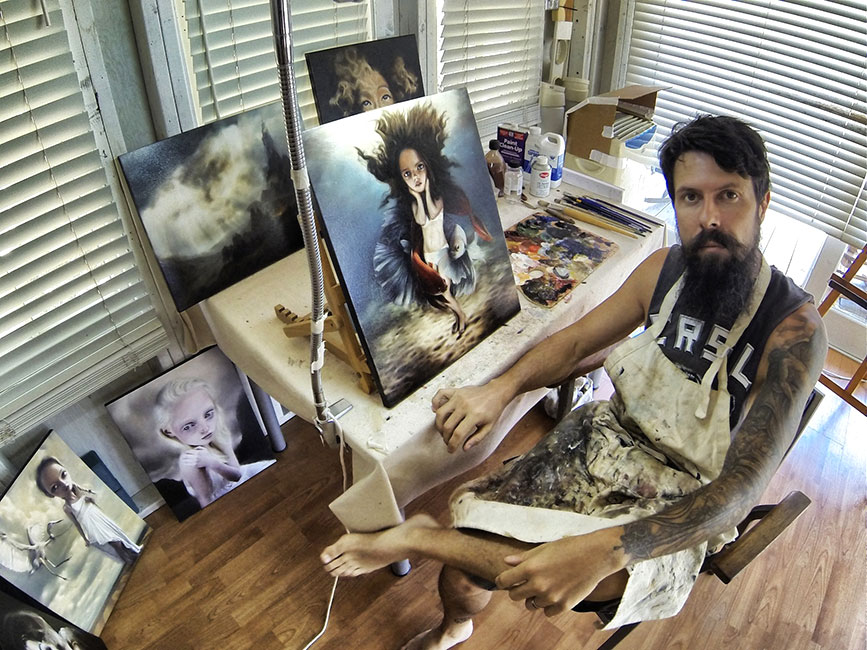Richard J Oliver’s beautifully rich and profoundly rewarding imagery invokes a lexicon of visceral sentiments within us, which encourage our inevitably deep rooted emotional connections with his subjects. Oliver invites us to accompany him on his unfolding inner journey, through which he navigates the rocky terrain of the human condition. His paintings explore a myriad of themes attached to our search for greater awareness, of both our own interior landscapes and the external world around us. Favourite aspects of our existence for his consideration and enquiry, include: innocence, youth, struggle, survival, hope, fear, beauty and continuity. This subject matter is handled with the utmost sensitivity, which arrives before us having been filtered through Oliver’s perceptive wisdom. A wisdom he has nurtured through years of living a inspiringly receptive and considered life, the interpretation of which, is a credit to his discerning instropection and tenacious soul searching.
Richard J Oliver was born in 1975 in Pontypridd, Wales, UK and he currently lives and works in Los Angeles, CA. He studied Fine Art at the University of the West of England and undertook his Masters at UWIC in Wales. Richard has since gained significant recognition for his work, which has been exhibited in galleries and museums around the world, including the prestigeous Museum of Modern Art in Wales and the renowned Corey Helford Gallery in LA.
WOW x WOW is eternally grateful to Richard for engaging with the questions we set for him, to such an extent, that he provided the astounding insight and humbling honesty you will undoubtedly enjoy in the following interview. Thank you Richard!
Hi Richard! Thanks ever so much for freeing up some of your valuable time to have this wee chat with us, we really appreciate it. To get the ball rolling, can you tell us about where you are currently living and what you like most about the area?
Hi Tim, thanks for inviting me to participate in this interview. I am currently living on the northern fringe of Los Angeles county, in the mountains, pretty close to the Hells Angels headquarters and Spahn Ranch, which was the primary residence of the infamous Charles Manson. As you can imagine, there’s quite an eclectic mix of folk and it’s crazy enough for me to fit right in. What sold the place to me, was when my wife and I were looking at properties in the area and we saw a bloke, with a big white beard, a sailors hat, covered in tattoos, driving a golf cart up the street with his lady, while enjoying a glass of red wine. I knew right then that this was the place for me. Another aspect which fills me with joy is the mountainous landscape. As a boy from Wales, I am drawn to the mountains and often run and meditate in the hills near my house. It gives me a sense of openness and freedom, and there’s also lots of places to escape and hide should the zombies come, or (in all seriousness), we run out of water and people start going nuts with their guns.
As you just mentioned, your home country is Wales in the UK, where you spent the first 30 odd years of your life. Now having lived in LA for a number of years, what do you feel are the predominant aspects of your Welsh upbringing that you still find seeping through into your art?
I’m not so sure any specific content or subject matter from my homeland is directly finding it’s way into my work, but my upbringing does impact how I approach my art. I’ve become aware that I still struggle with unworthiness and the imposter phenomenon. Let me explain. I never feel quite good enough. To use a metaphor, if I were a cup, I imagine my cup to be full alright, but unfortunately the cup I imagine myself as is small. I am aware that I struggle to hold an appreciation for anything I do and often hear my voice both inner and outer putting myself and my abilities down. I don’t think this is a result of my family upbringing (which was always loving and encouraging), but I sense it has something to do with the cultural identity adopted from the place where I grew up; a feeling of always being the underdog and expecting things to go wrong.
Even when I was at the height of my career in music, I (we) still felt as though the world was against us and carried a fear of being unaccepted. This sense of inferiority of course isn’t unique to Wales and the Welsh but it seems to be part of me and something I have still to learn to overcome. It affects my art directly, in that I am embarrassed when I receive compliments on my paintings, and am perpetually frustrated that my paintings say nothing, or could be saying/doing so much more to bring joy, awareness and happiness to people if only I could just connect the dots. I guess I still feel like I haven’t started art yet and that I am a child still practising techniques, constantly being dragged in all directions, seeking the approval of others. One consolation is that I can now at least witness this mess I’m in.
You have stated that the Glasgow Boy, Peter Howson was an early influence on you. Your work tackles themes which were a common source of inspiration for Howson too, such as the struggle and survival of individuals in unfortunate circumstances. Can you give us some insight into what initially attracted you to these themes and how you have approached addressing them over the years?
I was initially drawn to Peter Howson’s work in University. One of the final year students, an ex army guy who had lost his hearing while serving, if I recall correctly, was making these huge, dark figurative paintings in a cartoon, caricature style. His work lead me directly to discover Howson’s paintings and I immediately became obsessed. At the time I was incredibly disillusioned with university and in my quest for grades and tutor approval I was doing anything except follow my heart. It eventually got to me and I decided to spend my final year making paintings which I would be proud to take home and show my friends. I moved out of the Uni and into a derelict WW2 bomb shelter under a grammar school, with my fellow artist and house mate and painted day and night. My main subject at the time was ‘Identity’ or the ‘lack of Identity’, having been raised on 80’s pop culture in the skeleton of an impoverished mining village. I painted my friends and made these big, claustrophobic, high contrast paintings with masculine forms and heavy black lines. I was drawn to the musculature and the manliness of the figures in Howson’s work and adopted everything about his technique.
In hindsight, I simply wanted to make provocative paintings and be as loud as possible. The problem was, although I had adopted a tough, loud voice (style), I had very little to say. It’s clear to me now that the large macho paintings was an overcompensating for my insecurities and fear of being small and insignificant. This has inadvertently lead me to where I am now with my art. I am embracing more of the feminine within me as a counterbalance to the years of fronting Carl Jung’s masculine warrior archetype. I’ve discovered it takes so much courage to reach beneath the armour and reconnect the vulnerable heart, and feel that this is the authentic work of a tenderling soul warrior. Now my paintings tend to be quieter and less chaotic. There is more space and calmness. Although there is not always peace in my paintings there is a sense of poise. I explore more diverse aspects of our human condition in my current paintings, especially the unbearable beauty and the precious vulnerability and fragility of this human incarnation, often perilously balanced together in the same painting. My current themes may be the polar opposite to what I was initially attracted to in Howson’s work, but I find myself at the other end of the very same stick, so in a way they are directly connected.
The protagonists in your paintings generally share the common bond of youth. However, many of them display the characteristics of an almost accelerated maturity, as if they have been forced to grow up to soon. Would you say this observation has any validity, and if so how do you approach the balancing of innocence and maturity?
I had a vision while running in the mountains a little while back. I saw myself as a toddler in a garden with other toddlers. We explored our space with confidence and in safe security. We then began to play games with each other and laugh and revel in the joy of life. As the day wore on, we all started to get a little cranky and hungry. The games started to get a little serious, jealousy and competitiveness became prevalent. The games had lost their fun and the children were trying to accumulate the most of winnings and attention. I stepped away from the games and wandered into the garden and before I knew it, it became late afternoon. I was lost, alone, and out of sight of the house. I sat frightened and in despair. After a long while I heard a kind and familiar voice. It told me that everything will be OK. Inevitably, I will be guided back to the house, the safety of home, to sleep and that I should make the most of the reminder of the day in the same security and curiosity that I had early that morning. Relinquish the fear and reconnect with the joy of life before the day is out.
In retrospect it was a metaphor for my life. I have chosen to psychologically leave the tribe and have found myself alone and often perplexed, but I see now that I will have to return to the source of whence I came, as Rumi said:
“I didn’t come here of my own accord, and I can’t leave that way. Whoever brought me here, will have to take me home.”
I am opening to the innocence of the sapling at my core and trying to see with the eyes of the ageless awareness within. I hope that this is somewhat subconsciously reflected in the connection between youth and maturity in the characters of my paintings, though of course I can’t be sure. Many of my paintings feel like self portraits, regardless of their gender. Portraits of myself, not as an individual, but as a universal self having many human experiences. Of course I am also drawn to the beauty and innocence of youth, as I notice it inevitably leaving my physical body, and I wonder if this is why my work resonates with others. I feel we are all drawn in one way or another to our first encounter with the powerful feeling of love and acknowledge it may never be as new or as raw as it was when we were young, therefore the youthful beauty of the characters of my work may spark this attachment and longing within all of us to our own memory of a heart fluttering love of life.
Finally, there is a deep fear expressed in my paintings. A fear of being impotent to protect my own young family. Many of my paintings are about survival. The characters are indeed sometimes portrayed in difficult situations or conditions. My intentions are not to glamorise or beautify the horror of their condition, but to depict their struggle, always with a light at the end of the tunnel. The titles of some of my first paintings still ring true in my work with predominant themes being Hope, Survival and Continuity. The figures and characters are often escaping some sort of abuse, overcoming tragedy and loneliness in their survival, much like myself. It is one of the most tragic images to see a child having to fend for themselves with a weapon, especially when they should feel safe and cared for. This image reoccurs in my work because of my concern for my own children and also all children in a world which can be ignorant and self destructive, but also because I feel that we are all forced to grow up too soon, and that the return part of my journey (in the second half of my life) is how to unlearn all this fear and desire for control and security, and reconnect with the source of life which always provides, nurtures and is unconditionally giving.
It is clear from the environments you place your protagonists in that you have concerns about the world and humanity’s role in the future of our civilization. Would you be willing to discuss some of the main areas of contemporary life that fill you with the most dread and fear for humanity and our youth?
It is true that if you look for it (and you don’t have to look hard with today’s news media) you will find devastation, suffering and all the ugliness that life has to offer. I have however, as a matter of emotional health, turned away from the news media’s projection of life and am trying to tend to my own internal garden space. It takes so much discipline for me not to look at only the weeds and the decay of my internal landscape, and I put much effort into abstaining from comparing my garden to others seemingly more affluent gardens, metaphorically of course.
So, in saying all this I wish to turn my attention away from the things that fill me with the most dread and fear and instead actively engage in seeking out the beautiful. I always try and keep the language of beauty as my primary expression in my paintings. This quote by columnist Mark Morford describes it much better than I could ever:
“Stop thinking this is all there is… Realize that for every ongoing war and religious outrage and environmental devastation, there are a thousand counter-balancing acts of staggering generosity and humanity and art and beauty happening all over the world, right now, on a breathtaking scale, from flower box to cathedral… Resist the temptation to drown in fatalism, to shake your head and sigh and just throw in the karmic towel… Realize that this is the perfect moment to change the energy of the world, to step right up and crank your personal volume; right when it all seems dark and bitter and offensive and acrimonious and conflicted and bilious… there’s your opening.
Remember the mystery.
And finally, believe you are part of a groundswell, a resistance, a seemingly small but actually very, very large impending karmic overhaul, a great shift, the beginning of something important and potent and unstoppable.”
You have mentioned that identity is an issue prevalent in your art. How autobiographical is this aspect of your work?
Most of my paintings are reflective of the universal human condition of which we are all part of and partake in. Therefore my paintings are from the true self and are of aspects of reality which evoke emotions and feelings that belong to all of us, so in a way each of my paintings is autobiographical. I often look to poetry as my inspiration to express a communicative visual language in my paintings. I try to treat the content and the details of my paintings as though they were chosen words and instead of using words simply to describe what is there, I wish to use words that evoke specific feelings and emotions, both in me and hopefully in others. Therefore, even though the subjects and characters in my paintings do not represent me physically, they are personifications of creative impulses and responses within me and are therefore equally ‘of me’, just as my voice is mine, even though the sounds I use may be universal and subjective. The language and words (subject and content) I use in my paintings may never describe the intended emotions I wish to evoke, but hopefully act as the vessel and mechanism to lead the viewer to experience the same feelings which drove me to make the painting.
I feel as though I have relaxed a little on my pursuit of identity and focused my search on the meaning and purpose of life. Identity feels like an outward, feeling part of, or fitting in, (individual in relationship with the external world) aspect of character and one to which I devoted most of my study in the past. More often these days I am practising presence, which requires a more soft and fluid mind and identity seems too ridged a concept of self to fit with such a transient experience of awareness and presence – less a human being having a universal spiritual experience, but more a universal spirit having an individual human experience.
What are your opinions about beauty in reference to man made artefacts? Is beauty something that you search for in art and is it something you consider when producing your own work?
Beauty within visual art has become of primary purpose to me. This is both to help my own mental well being and also to responsibly counter the negativity bias of our culture and society. It is however one of the most difficult undertakings and quite often (more than I wished) I miss the mark entirely. I have discovered it is so much easier both in art and music to play a minor chord or paint an apocalyptic scene and pluck the melancholy string of the heart. To make a painting that expresses joy, beauty and love without seeming sentimental, kitsch and overly saccharine is very challenging. It is however a virtuous path that I must take and am committed to finding a way to make my paintings help, inspire and deepen a wealth and joy in people.
Storytelling and narrative are at the heart of the art you make. In your opinion, what are some of the most important ingredients that go into making a successful and compelling visual narrative?
I’m glad you asked, because I have discovered that narrative is nigh impossible in single representational scenes and paintings, because as Aristotle wrote on narrative structure, you need a beginning, a middle and an end. Beginning has no determining cause and ending has no effect. Since a representational painting is most often a still of a moment in time, it in itself can have no cause and effect, no beginning, middle and end contained in it, other than an implied cause or implied effect. Therefore, all so called narrative paintings are more accurately implied narrative and have to take into account the many assumptions, especially those of the viewer. I have often adopted renowned fairy tails or well known myths in order to allow the narrative to be carried by the viewer and brought to the familiar scene in my paintings. This of course assumes that the viewer knows the story and is aware of the cause and effect of the given moment or scene in my painting. Without painting multiple frames like a comic book series or a themed show where each painting is somewhat chronological the narrative is always implied and assumed.
That being said, I try not to fit too many superfluous elements into my work and try to only use structures, tools and content that supports and directs the intended emotional expression. I’ve been guilty of adding elements to past work that deliberately made the painting ambiguous, to cover up a lack of direction, but that was only because everyone else was doing it and at the time and I didn’t think it was detrimental. These days I try to keep it to the point and omit anything that doesn’t add strength to the implied narrative, or takes away from the feeling I wish to share and evoke.
I do however believe that representational art is a language we use to communicate. And I am compelled to paint, not simply to fulfil personal gratification, but to take the extra step, by emotionally connecting with other people and sharing the beauty of creating.
Having expressed an appreciation for the writings of Jung and an interest in the role of your subconscious mind in your creative process, can you speak a little about how you nurture the ideas your subconscious presents you with? Do you have any rituals or practices which help to open the floodgates, so to speak?
I’m not so sure that what I once thought of as the subconscious was actually correct. I’ve come to learn that the subconscious is exactly that – below the conscious mind, so in essence, I can’t claim that I can know or experience anything that lurks below the conscious mind without being at least suspicious of where it arose from, or where it was adopted. I have to be honest, I was quick to spurt out rhetoric a little while back as my inner journey was opening up to me. I confess I am guilty of having my mind blown by the words and writings of our great thinkers and guides, only to slip back into the dull and shallow thought patterns of my former being a few weeks later. So as much as I appreciated the wisdom of Jung, I can’t entirely say I grasped all that he spoke of and I would often quote from him more to gain the approval and praise of others in place of living and applying the lessons. When approaching each blank canvas, I thought that if I simply followed my gut instincts, the raw feelings of my animal nature, I was being guided by a pure and direct energy from intuition and the source of all creativity, but in hindsight I’m not sure that anything of real value came into my paintings and most of the works were devoid of any helpful meaning or clarity other than looking and feeling pleasing to the eye. It was almost as though some of the pieces of the jigsaw puzzle fitted together sort of well, but it wasn’t representing the picture that it should have on the cover of the box. I feel I went too far to the other side in trusting entirely my gut response to guide the process because it admonished me of any responsibility of deliberate conscious decisions and I fear it was just a lazy excuse not to give constructive thought to the paintings. I’m definitely guilty of taking Emerson and his self reliance too literally.
Of late, I have been practising a little more analysis of the seed ideas and writing down the imagined image, the intent, the emotions and hashing it out in words, to try to conceive a visual poem with brainstorming before I even put brush to canvas. My paintings are therefore a little less haphazard and ambiguous. I feel like I was naive when I said, my hand is the universe working through me, and God did it. Of course, now I get tangled up in thought and most ideas never make it past the first few judgements and scrutiny, but I hope that the ones that make it into final paintings are all the better for the analytical efforts.
To almost contradict myself (Emerson would be proud), I do however still pay attention to ideas that come to me when in deep meditation or many hours into my mountain runs. I have faith that these ideas, when my mind and body are exhausted, are born from a place of quiet clarity. Unfortunately, my mind is so active and loud almost all the time, that I miss most of the intuitive thoughts from the peaceful silent inner self. I’ve learned to recognise these ideas when they do surface, because usually they come complete in hi-definition with all the information needed already present. I guess my ritual of running long distances could be considered a practise in nurturing the holistic right brain in order to open the floodgates.
You have a very altruistic streak, having worked with and aided numerous children’s charities. How did you initially get involved in this?
I first got involved with charity because I was deeply affected when my aunt lost her battle with cancer. I was on the Warped Tour with my band and I became friends and received a lot of support in that painful time, from a chap named Rob Dyer who founded Skate4Cancer. It was only natural that I should return the love and support by donating proceeds from the sale of my paintings to the cancer charity Dream.Love.Cure (affiliated with Skate4Cancer). Since then, I have focused on the afflictions that affect each of my children which are Williams Syndrome and Autism. Raising two children with special needs provides one with many opportunities to discover what lessons have yet to be learned and what personal weaknesses need to be addressed. I often donate or auction work to support both charities and we also receive so much valuable support for the non profit organisations themselves.
As we move through life we continue to grow and change. In what ways have you seen your work evolve since you started down the path of being a professional artist?
I’ve witnessed my art turn from a career into a vocation. It was not too long ago that I discovered the difference between these two paths. I used to create paintings as a means to an end, with the end being financial security for my family. Now my paintings have taken on a greater meaning than just myself and my family. The paintings I make aim to be a bridge between all people and a way to connect in this fleeting and fragile thing we call life, a way to bring happiness and spiritual wealth to people in a time which is dominated by insatiable pleasures and shallow cyber interactions. I hope to become of more emotional and spiritual service to others and share the wisdom I hope to finally learn and apply from our awakened leaders, by way of my passion for painting and creating. I still have no real idea how, but have faith that if this is my true calling and vocation, I can put it to some good use, to heal and to guide.
In order to get a better understanding of the personality of an artist, it can help to get a peek behind the curtain. Would you be willing to share a story from your own life, one which you feel has contributed to shaping the person and therefore the artist you are today?
Of course. Within the space of 3 years this past decade, I was deeply betrayed and then emotionally heartbroken on two separate occasions. For 12 years I had committed myself to making music with a band who acquired remarkable success for their endeavours. Toward the end of the relationship I had become emotionally and creatively imprisoned, mainly by a man who had succumbed to horrendous drug abuse. I was unable to grow as an individual because of my marriage to the groups identity and I was in golden handcuffs, unfulfilled creatively, but unwilling to leave because of a lack of confidence in myself and my personal abilities. I had a family to keep and I couldn’t imagine ever providing for them in the same way if I left the music industry and returned to my painting. This decision was taken out of my hands when my friend (and singer) of almost 15 years, began taking drugs and finally ended up getting arrested and convicted of an abhorrent crime. Our career and 12 year legacy was permanently obliterated in a second. I was forced to face up to my individual responsibilities and began to paint again.
Less than a year had passed (after losing all faith in people and condemning myself for being such a terrible judge of character), when my life was turned upside down again. We discovered that our 11 month old youngest son has a genetic condition called William Syndrome. Any idea of the future my family and I had imagined was extinguished and we were left with a terrifying unknown in its place. Close friends abandoned us, either because they couldn’t cope or because they were not equipped to help.
The third event, which pushed me over the edge, was finding out out eldest son had Autism. This for me was the hardest, because I had of course known him for much longer and my ideas of who he was and could become had solidified in me. It was an excruciating lesson to learn and one that has left me fragile and deeply changed. All of these events have had a direct and indirect impact on my life and my artistic expression. I am grateful for the lessons they have provided me with and for shaping and nurturing my new character. Hopefully I can become a person that is less driven by pride and others approval and more able to effectively be of service to those around me, both near and far.
What is your relationship with art history? Do you feel it is important for artists to have a knowledge and understanding of what has gone before them?
My most treasured scholastic experience was learning about the Impressionists and Post Impressionists during art class in sixth form. I was probably 15 or 16 when my teacher John Collins first exposed me to Post Impressionists such as Manet and Cézanne. Since then, my life has been on and off in terms of art history study, but I attest to studying the art of the great masters and everything that followed as a necessity if an artist is to really understand his/her craft. Not only are there endless deeply embedded, tried and tested techniques for enhancing the modern day artists skills and knowledge base, but of course the psychological implications of studying the intent, direction, meaning and purpose behind all of our great artists go without saying. I personally try to study old methods of composition, medium preparation, techniques of drawing and painting weekly and fortunately the internet allows for so much information gathering that was not available when I undertook my formal training.
If you could own one piece of art from the world’s collections, what would it be and why?
Surprisingly, after thinking long and hard about this question, I’ve found that I actually do not wish to own any art. Ownership counts for nought, compared to what the painting is freely able to share and communicate with people. Our galleries and museums are open to all, and the message of the artist is free for all to enjoy without needing to have personal ownership rights. I truly don’t think that a thousand lifetimes would exhaust all that our great and small galleries have to offer us and each are constantly growing and changing.
However, not to seem overtly pretentious or evasive, if I was allowed infinite access at any given time to any piece of artwork ever made, I would probably choose a sculpture I saw as a young artist of a huge black Minotaur hunched over, staring at its human hand. I have never discovered who or where the sculpture is and cannot source it on the internet, but when I first set eyes on it in a book in university, it resonated with me deeply. It symbolised the dichotomy of our human incarnation perfectly for me, and the struggle we have as an awakened conscious mind trying to grasp reality and make sense of life within the limitations of an evolved, yet partly unconscious animal body. If I could find this bronze sculpture, I sure would like to visit it often.
What’s next for Richard J Oliver?
I might attempt a solo show in 2017. I also hope I can find a way to use my passion for painting in a more constructive and helpful way and I hope that I can share my growing love and joy for life and my growing compassion for living organisms (myself included), to as many people as possible, in as clear and positive a way as I am able.

